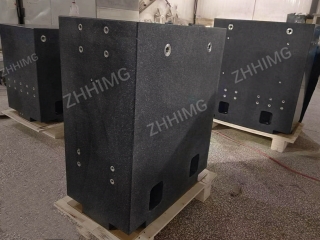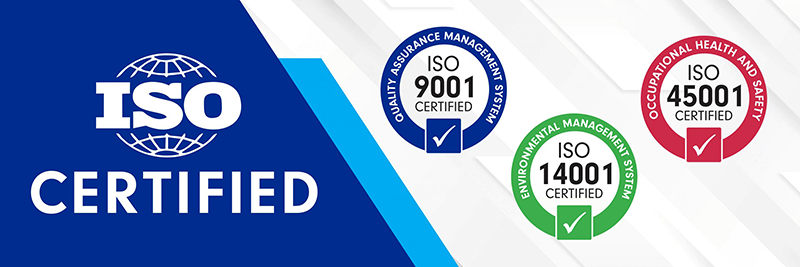In CNC numerical control equipment, although the physical properties of granite provide a basis for high-precision processing, its inherent drawbacks may have multi-dimensional impacts on processing accuracy, which are specifically manifested as follows:
1. Surface defects in processing caused by material brittleness
The brittle nature of granite (high compressive strength but low flexural strength, usually the flexural strength is only 1/10 to 1/20 of the compressive strength) makes it prone to problems such as edge cracking and surface microcracks during processing.
Microscopic defects affect precision transfer: When performing high-precision grinding or milling, tiny cracks at the tool contact points can form irregular surfaces, causing the straightness errors of key components such as guide rails and worktables to expand (for example, flatness deteriorates from the ideal ±1μm/m to ±3~5μm/m). These microscopic defects will be directly transmitted to the processed parts, especially in processing scenarios such as precision optical components and semiconductor wafer carriers, which may lead to an increase in the surface roughness of the workpiece (Ra value increases from 0.1μm to over 0.5μm), affecting optical performance or device functionality.
Sudden fracture risk in dynamic processing: In scenarios of high-speed cutting (such as spindle speed > 15,000 r/min) or feed rate > 20m/min, granite components may experience local fragmentation due to instantaneous impact forces. For instance, when the guide rail pair changes direction rapidly, edge cracking can cause the motion trajectory to deviate from the theoretical path, resulting in a sudden drop in positioning accuracy (the positioning error expands from ±2μm to more than ±10μm), and even leading to tool collision and scrapping.
Second, dynamic accuracy loss caused by the contradiction between weight and rigidity
The high-density property of granite (with a density of approximately 2.6 to 3.0g/cm³) can suppress vibration, but it also brings the following problems:
Inertial force causes servo response lag: The inertial force generated by heavy granite beds (such as large gantry machine beds that can weigh tens of tons) during acceleration and deceleration forces the servo motor to output greater torque, resulting in an increase in position loop tracking error. For instance, in high-speed systems driven by linear motors, for every 10% increase in weight, the positioning accuracy may decrease by 5% to 8%. Especially in nanoscale processing scenarios, this lag can lead to contour processing errors (such as the roundness error increasing from 50nm to 200nm during circular interpolation).
Insufficient rigidity causes low-frequency vibration: Although granite has a relatively high inherent damping, its elastic modulus (about 60 to 120GPa) is lower than that of cast iron. When subjected to alternating loads (such as fluctuations in cutting force during multi-axis linkage processing), micro-deformation accumulation may occur. For instance, in the swing head component of a five-axis machining center, the slight elastic deformation of the granite base can cause the angular positioning accuracy of the rotation axis to drift (such as the indexing error expanding from ±5" to ±15"), affecting the machining accuracy of complex curved surfaces.
Iii. Limitations of Thermal Stability and Environmental Sensitivity
Although the coefficient of thermal expansion of granite (approximately 5 to 9×10⁻⁶/℃) is lower than that of cast iron, it may still cause errors in precision processing:
Temperature gradients cause structural deformation: When the equipment operates continuously for a long time, heat sources such as the main shaft motor and guide rail lubrication system can cause temperature gradients in the granite components. For instance, when the temperature difference between the upper and lower surfaces of the worktable is 2℃, it may cause mid-convex or mid-concave deformation (deflection can reach 10 to 20μm), leading to the failure of the flatness of the workpiece clamping and affecting the parallelism accuracy of milling or grinding (such as the thickness tolerance of flat plate parts exceeding ±5μm to ±20μm).
Environmental humidity causes slight expansion: Although the water absorption rate of granite (0.1% to 0.5%) is low, when used for a long time in a high-humidity environment, a trace amount of water absorption can lead to lattice expansion, which in turn causes changes in the fit clearance of the guide rail pair. For instance, when the humidity rises from 40% RH to 70% RH, the linear dimension of the granite guide rail may increase by 0.005 to 0.01mm/m, resulting in a decrease in the smoothness of the sliding guide rail's movement and the occurrence of a "crawling" phenomenon, which affects the micron-level feed accuracy.
Iv. Cumulative Effects of Processing and Assembly Errors
The processing difficulty of granite is high (requiring special diamond tools, and the processing efficiency is only 1/3 to 1/2 of that of metal materials), which may lead to the loss of accuracy in the assembly process:
Processing error transmission of mating surfaces: If there are processing deviations (such as flatness > 5μm, hole spacing error > 10μm) in key parts like the guide rail installation surface and lead screw support holes, it will cause distortion of the linear guide rail after installation, uneven preload of the ball screw, and ultimately lead to deterioration of motion accuracy. For example, during three-axis linkage processing, the verticality error caused by the distortion of the guide rail may expand the diagonal length error of the cube from ±10μm to ±50μm.
Interface gap of the spliced structure: Granite components of large equipment often adopt splicing techniques (such as multi-section bed splicing). If there are minor angular errors (> 10") or surface roughness > Ra0.8μm on the splicing surface, stress concentration or gaps may occur after assembly. Under the long-term load, it may lead to structural relaxation and cause accuracy drift (such as a decrease of 2 to 5μm in positioning accuracy each year).
Summary and coping inspirations
The disadvantages of granite have a covert, cumulative and environmentally sensitive impact on the accuracy of CNC equipment, and need to be systematically addressed through means such as material modification (such as resin impregnation to enhance toughness), structural optimization (such as metal-granite composite frames), thermal control technology (such as microchannel water cooling), and dynamic compensation (such as real-time calibration with a laser interferometer). In the field of nanoscale precision processing, it is even more necessary to conduct full-chain control from material selection, processing technology to the entire machine system to fully leverage the performance advantages of granite while avoiding its inherent defects.
Post time: May-24-2025


